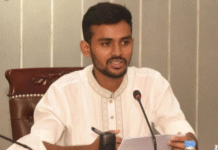Involve jobless youth in development

The general economic division of Bangladesh’s planning commission has put forward a rather dismal picture of the country’s youth. The report shows that 29.8 per cent of the young people aged between 15 and 29 neither have jobs nor do they study. A year ago this number stood at 27.5 per cent. That means, in a span of one year, there has been over a two per cent rise of youth who are not working nor studying. No matter what the economic indicators may show for Bangladesh, sustainable development will remain a pipedream unless the youth are involved in the country’ development process.
If a non-government agency of foreign institution put out these figures, the government would have protested vehemently. However, this report has been drawn up by the planning commission’s general economic division. The rate of education has increased in the country with a 100 per cent enrolment rate in primary schools. The economy has seen tangible growth. All this undoubtedly goes to the government’s credit. However, it does not seem that the government has any specific planning when it comes to utilising the services of the educated youth. In developed countries, education is closely linked with employment. The education system aims at preparing a workforce to meet the demands of the country and also the requirements of possible overseas employment.
All surveys, local and international, indicate that Bangladesh has a high rate of unemployed educated youth. That means the state is failing to give jobs to the young people, even after providing them with higher education. Their families and the state have invested hugely in them. Statistics show this problem is steadily increasing. It is time to look where we are headed. The government often declares that youth is power, but it is not utilising them in the development process. How long can be ensure sustainable development in this manner?
According to the International Labour Organisation (ILO) report on regional employment, Bangladesh’s percentage of unemployed youth has doubled from 2010 to stand at 12.8 per cent in 2017. Among educated youth, the unemployment rate is 10.7 per cent, the second highest among 28 countries of Asia and the Pacific region. Unemployment has gone up further this year. Unemployment is one of the major reasons behind the increase in crime and drug addiction in the country too. The Sustainable Development Goals (SDGs) aim to bring down the number of youth who are neither working nor studying to 22 per cent by 2020. Will it be possible to fulfil this goal in these two years?
Economist and former caretaker government advisor Wahiduddin Mahmud has said that youth unemployment is one of the major problems of the country. Employment must be generated to accommodate this large number of young people. This calls for increased investment, but investment in the private sector has almost come to a standstill over the past few years. The bureaucratic and infrastructural obstacles to investment must be removed.
It is a matter of concern that though it had been projected that 3.9 million jobs would be created in 2016-17, only 1.7 million were actually created. The government needs to change its planning. Priority must be given to involving the youth in the development process so no young person is forced to remain idle.









